Бұл материал сайт қолданушысы жариялаған. Материалдың ішінде жазылған барлық ақпаратқа жауапкершілікті жариялаған қолданушы жауап береді. Ұстаз тілегі тек ақпаратты таратуға қолдау көрсетеді. Егер материал сіздің авторлық құқығыңызды бұзған болса немесе басқа да себептермен сайттан өшіру керек деп ойласаңыз осында жазыңыз

Бонусты жинап картаңызға (kaspi Gold, Halyk bank) шығарып аласыз
1 жыл бойы тегін жүктеу мүмкіндігіне ие болыңыз!

жеңілдік
Formative Assessment tasks for the 3rd grade Family and Friends

FAMILY AND FRIENDS 1. KAZAKHSTAN EDITION
Tamzin Thompson, Naomi Simmons
Kamila Beibitbayeva, Julie Penn
OXFORD UNIVERSITY PRESS
Formative Assessment
A collection of tasks
(Methodical recommendation)
English
Grade 3 (Terms 1-2)
2024-2025 school year.
TERM 1. Unit 1: Hello English! Lesson 1: Greetings and names
|
Learning objective |
3.4.2.2 use words and short simple phrases to complete a written text at a sentence level. 3.3.2.1 identify some familiar words and signs on illustrations /pictures in common everyday situations |
|
Assessment criteria |
Complete sentences with familiar names accurately. Mark correct answers by identifying familiar words and phrases. |
|
Level of thinking skills |
Knowledge and comprehension, application |
1 Write. Miss Jones * Tim * Billy * Rosy
What’s your name?

Descriptor:
A learner:
-
recognizes and writes the correct names.
-
uses capital letters for names.
-
spells names correctly.
2 Mark the correct answer ().
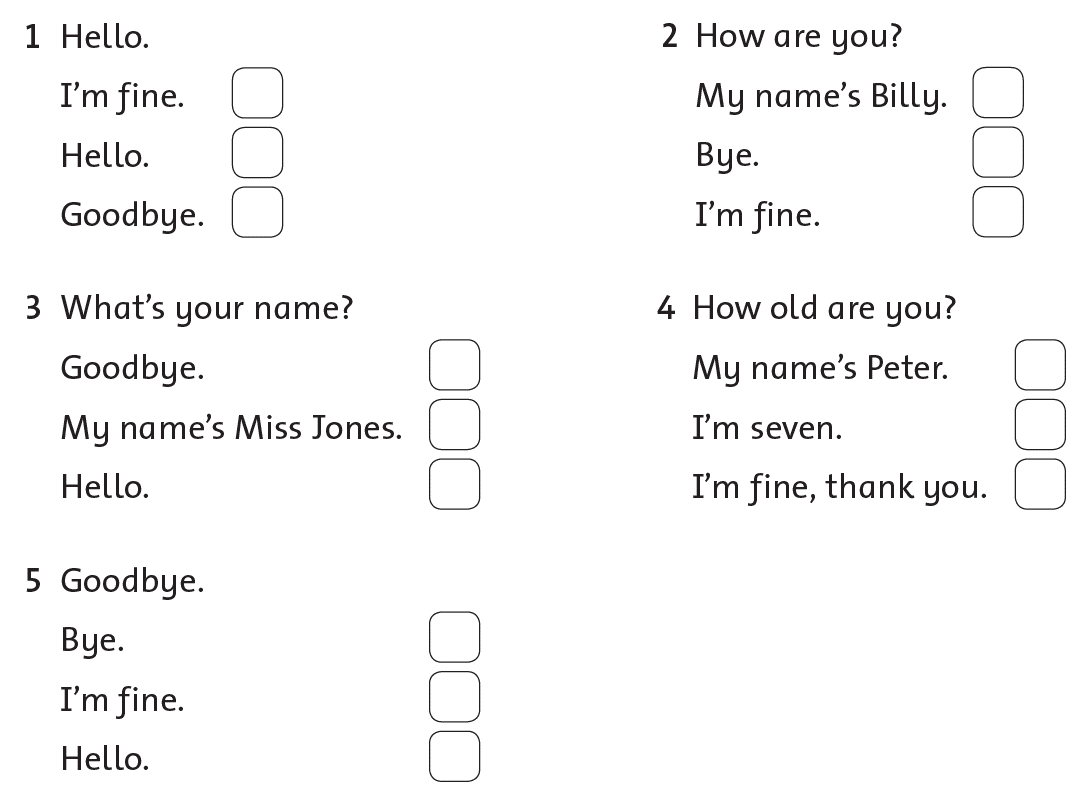
Descriptor:
A learner:
-
Reads the provided greetings or questions and multiple-choice options.
-
Identifies the correct response for each question.
-
Marks the correct answer () from the options given.
TERM 1. Unit 1: Hello English! Lesson 2: Greetings and names. The alphabet
|
Learning objective |
3.3.1.1 recognise sounds and name the letters of the alphabet 3.4.2.2 use words and short simple phrases to complete a written text at a sentence level |
|
Assessment criteria |
Name letters and associate them with their sounds. Complete sentences with appropriate words and phrases. |
|
Level of thinking skills |
Knowledge and comprehension, application |
Task 1. Join the letters.

Descriptor:
A learner:
-
identifies and reads each letter correctly.
-
follows the path to find the letters in order.
-
says the alphabet letters aloud in sequence.
2 Rewrite the sentences using the words in brackets.
1 What’s your name? (What is) What is your name?
2 My name’s Tim. (name is)
3 What is your name? (What’s)
4 My name is Rosy. (name’s)
Descriptor:
A learner:
-
understands the meaning of the sentence.
-
uses the words in brackets to rewrite the sentence correctly.
TERM 1. Unit 1: Hello English! Lesson 3: Introductions
|
Learning objective |
3.3.2.1 identify some familiar words and signs on illustrations/pictures in common everyday situations 3.4.2.2 use words and short simple phrases to complete a written text at a sentence level |
|
Assessment criteria |
Recognise familiar words and signs in visual contexts. Complete sentences with appropriate words and phrases. |
|
Level of thinking skills |
Knowledge and comprehension, application |
Task 1. Underline the correct word in brackets.

Descriptor:
A learner:
-
Reads sentences.
-
Chooses the right word.
-
Underlines the correct answer.
Task 2. Write.
name * you * I’m * Bye
* Hello *
Tim
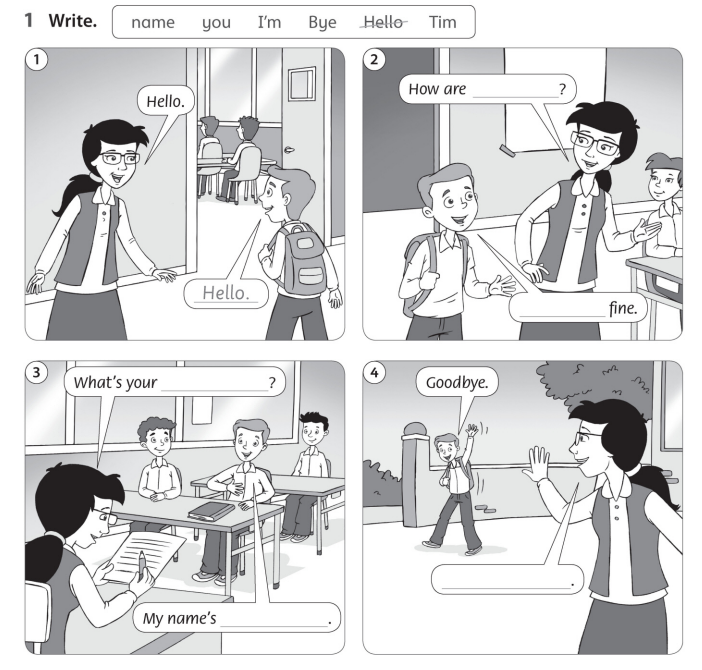
Descriptor:
A learner:
-
Reads given sentences.
-
Chooses the appropriate words to complete the sentences.
-
Writes the correct answers in the blanks.
TERM 1. Unit 1: Hello English! Lesson 4: Numbers 1–20
|
Learning objective |
3.5.1.3 use cardinal numbers 1-10; 11 - 20; 21 – 100 |
|
Assessment criteria |
Accurately count and use numbers within the specified ranges. |
|
Level of thinking skills |
Knowledge and comprehension, application |
Task 1. Draw lines to help each dog find its ball.
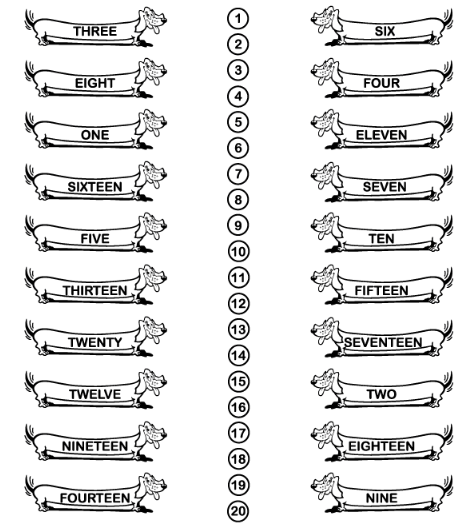
Descriptor:
A learner:
-
Looks at the pictures of dogs and balls with numbers.
-
Identifies the number on each dog.
-
Finds the ball with the matching number.
-
Draws a line from each dog to its matching ball.
TERM 1. Unit 1: Hello English! Lesson 5: Colours
|
Learning objective |
3.3.2.2 deduce the meaning of a word in a picture or icon on a limited range of topics |
|
Assessment criteria |
Infer the meaning of words using contextual clues from images. |
|
Level of thinking skills |
Knowledge and comprehension, application |
T ask 1.
Read and colour.
ask 1.
Read and colour.
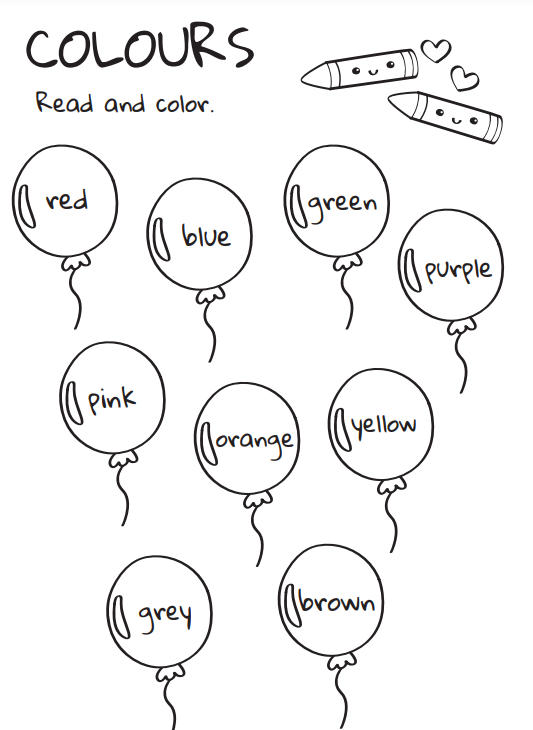
Descriptor:
A learner:
-
Reads the given words.
-
Identifies the colours mentioned in the sentences.
-
Colours the balloons according to the specified colours.
TERM 1. Unit 1: Hello English! Lesson 6: How old are you? Where are you from?
|
Learning objective |
3.4.2.2 use words and short simple phrases to complete a written text at a sentence level |
|
Assessment criteria |
Complete sentences with appropriate words and phrases. |
|
Level of thinking skills |
Knowledge and comprehension, application |
Task 1. Read and write.
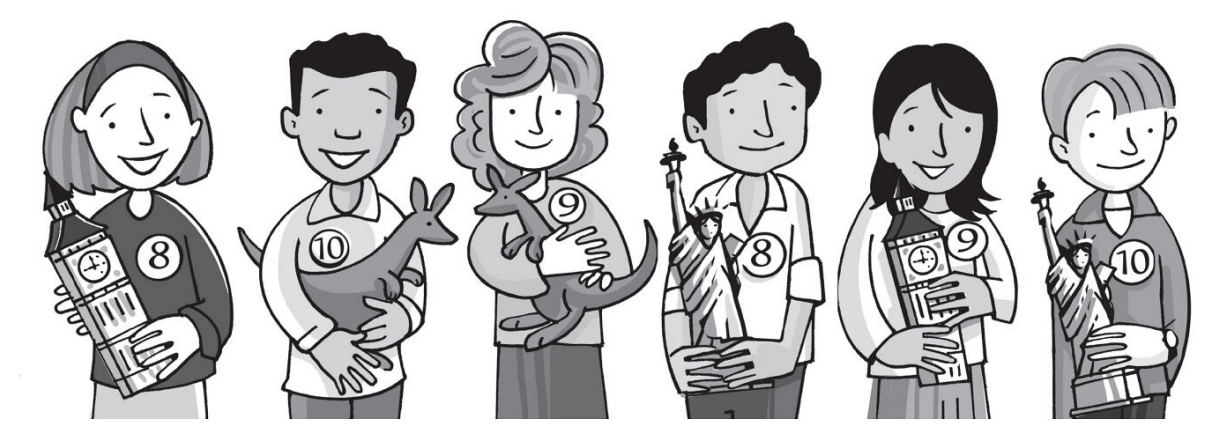
1 Jane is eight. She's from the UK.
2 Tom is … . He's from Australia.
3 Ellie is nine. She's from … .
4 Carl is … . He's from the USA.
5 Lisa is … . She's from the UK.
6 Jack is ten. He's from … .
Descriptor:
A learner:
-
Reads the sentences provided.
-
Identifies the missing information from the context.
-
Uses clues from the picture to complete the sentences accurately.
-
Writes the correct age or country in the blank spaces.
Task 2. Write about you and your friends.

Descriptor:
A learner:
-
Writes sentences about themselves and their friends.
-
Completes sentences with personal information.
-
Uses appropriate grammar and vocabulary.
Task 3. Write.
from * I'm * He's * It's * are you * meet * you * are
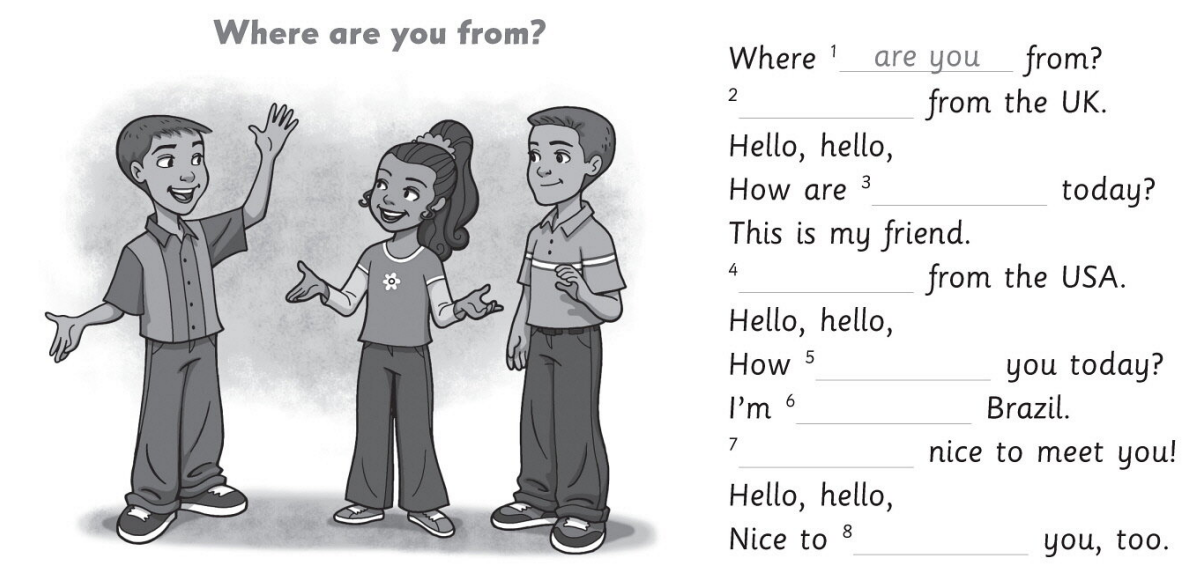
Descriptor:
A learner:
-
Reads provided sentences.
-
Selects the correct words to fill in the blanks.
-
Writes the accurate completions for each sentence according to the context provided.
TERM 1. Unit 1: Hello English! Lesson 8: At my school
|
Learning objective |
3.3.3.1 understand short, simple instructions used in familiar everyday contexts 3.3.2.2 deduce the meaning of a word in a picture or icon on a limited range of topics |
|
Assessment criteria |
Follow brief, straightforward instructions related to daily routines. Infer the meaning of words using contextual clues from images. |
|
Level of thinking skills |
Knowledge and comprehension, application |
Task 1. Point and say.
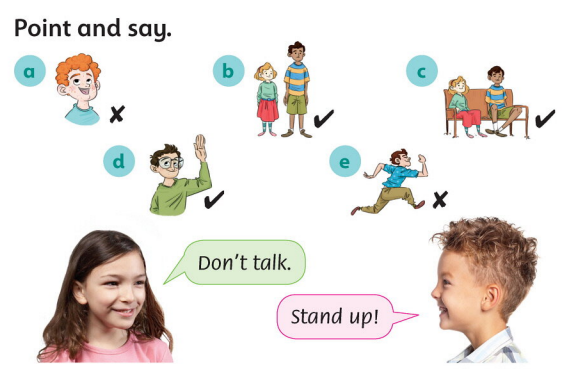
Descriptor:
A learner:
-
Observes the picture.
-
Verbally identifies and states the actions shown in the picture.
-
Points to the relevant parts of the picture.
Task 2. Look and complete. Colour.

Descriptor:
A learner:
-
Reads sentences describing the positions of balls in relation to objects in a picture.
-
Selects the correct prepositions (like "in front of," "behind," "between," etc.) to complete the sentences.
-
Writes the chosen prepositions in the blanks provided for each sentence.
-
Colors the balls according to the given descriptions.
TERM 1. Unit 2: My school. Lesson 1. Classroom objects
|
Learning objective |
3.4.1.1 spell accurately a few high-frequency words 3.5.1.2 use the verb "to be" for presenting personal information and describing people and things on a limited range of familiar topics |
|
Assessment criteria |
Spell high-frequency words correctly. Present personal information and describe people and objects using forms of the verb "to be." |
|
Level of thinking skills |
Knowledge and comprehension, application |
Task 1. Complete the words.

Descriptor:
A learner:
-
Reads incomplete words.
-
Selects the correct letters to fill in the blanks.
-
Writes the completed words accurately based on given cues.
Task 2. Order the words. Match.
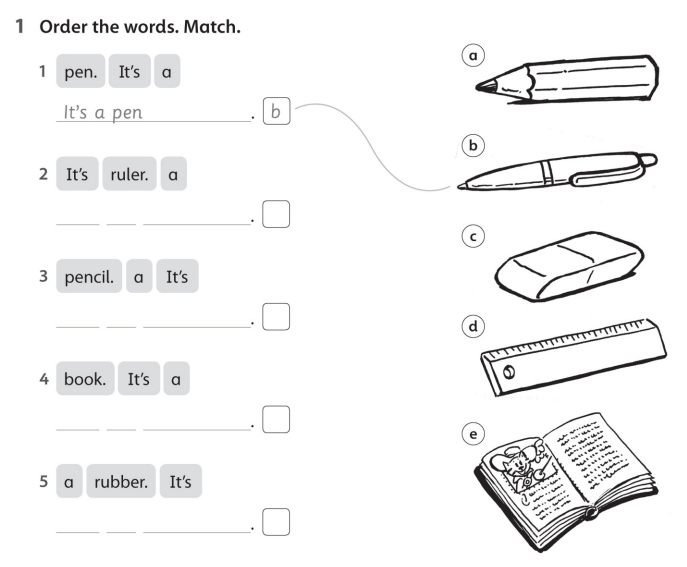
Descriptor:
A learner:
-
Looks at words and pictures.
-
Arranges the words in the right order to describe the pictures accurately.
-
Matches the phrases with the correct picture.
TERM 1. Unit 2: My school. Lesson 2. What’s this? What are these?
|
Learning objective |
3.4.2.2 use words and short simple phrases to complete a written text at a sentence level 3.5.1.1 use singular and plural nouns, including some common irregular plural forms and high-frequency uncountable nouns 3.5.1.7 use demonstrative pronouns this, these, that, and those to indicate things in closed questions with support |
|
Assessment criteria |
Complete sentences with appropriate words and phrases. Use correct singular and plural forms of nouns. Use demonstrative pronouns correctly in closed questions. |
|
Level of thinking skills |
Knowledge and comprehension, application |
Task 1.
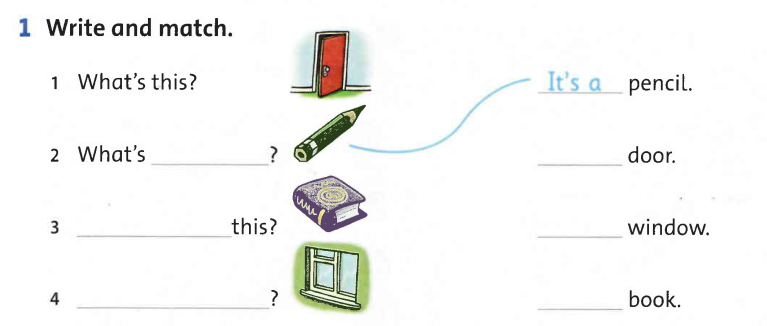
Descriptor:
A learner:
-
Reads simple sentences.
-
Chooses the correct words to complete the sentences.
-
Writes the correct answers in the blanks provided.
-
Matches the phrases with corresponding pictures.
Task 2. Write.

Descriptor:
A learner:
-
Looks at pictures depicting different people (man, men, woman, women, child, children).
-
Identifies and matches each picture with the corresponding word.
-
Writes down the correct word next to each picture based on their observation.
Task 3. Match.
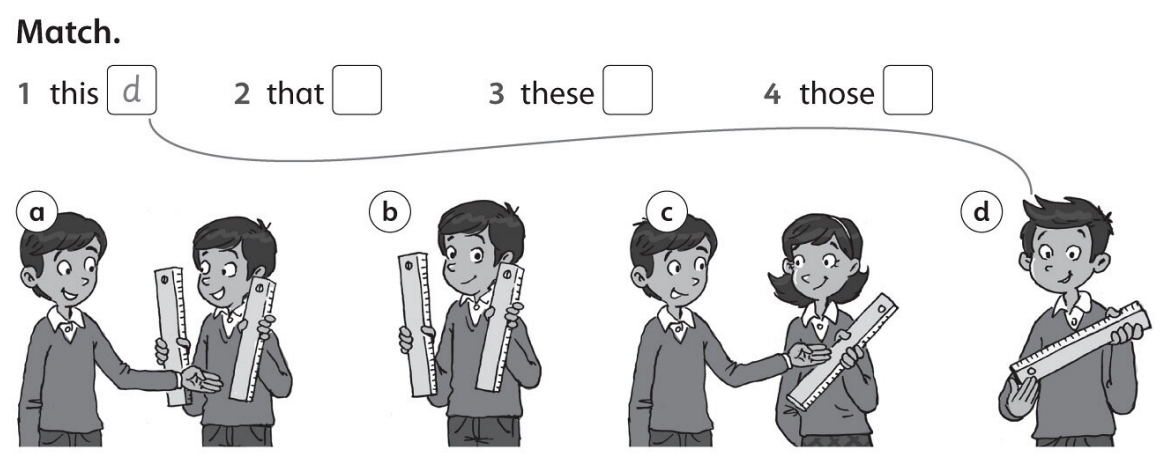
Descriptor:
A learner:
-
Views a set of images.
-
Identifies and matches each image with the corresponding word: "this," "that," "these," or "those."
Task 4. Match.

Descriptor:
A learner
-
uses this, these, that and those appropriately.
TERM 1. Unit 2: My school. Lesson 3. Classroom objects and instructions
|
Learning objective |
3.4.1.1 spell accurately a few high-frequency words 3.4.2.2 use words and short simple phrases to complete a written text at a sentence level |
|
Assessment criteria |
Spell high-frequency words correctly. Complete sentences with appropriate words and phrases. |
|
Level of thinking skills |
Knowledge and comprehension, application |
Task 1. Look and write

Descriptor:
A learner:
-
Looks at the crossword grid.
-
Examines the visual clues provided.
-
Fills in the correct words based on the clues.
Task 2.

Descriptor:
A learner:
-
Looks at the pictures of a door, window, and bag.
-
Reads the sentences "Open the …", "Close the …", "Open the …".
-
Chooses the right words (door, window, bag) to fit each sentence.
-
Writes the correct answers in the blanks provided.
TERM 1. Unit 2: My school. Lesson 4. Numbers 20-100
|
Learning objective |
3.5.1.3 use cardinal numbers 1-10; 11 - 20; 21 – 100 |
|
Assessment criteria |
Accurately count and use numbers within the specified ranges. |
|
Level of thinking skills |
Knowledge and comprehension, application |
Task 1. Write the numbers.
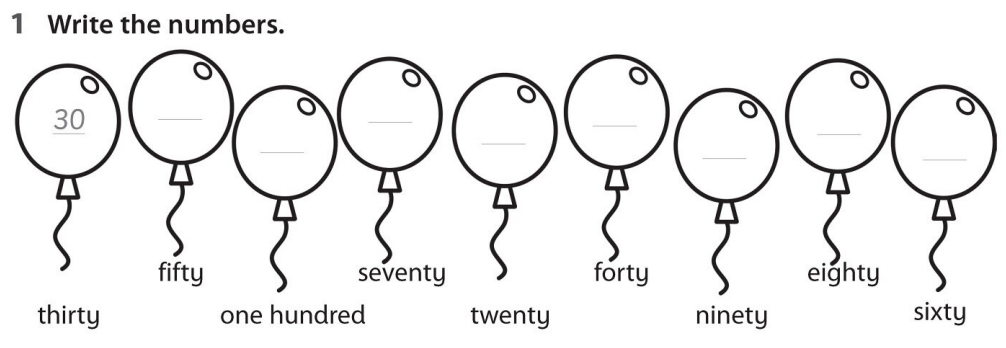
Descriptor:
A learner:
-
Recognizes the numbers provided.
-
Writes down the specified numbers accurately.
Task 2. Match.

Descriptor:
A learner:
-
Reads numbers and their corresponding words.
-
Matches each number to its correct word.
TERM 1. Unit 2: My school. Lesson 5. Describing things. There is, there are.
|
Learning objective |
3.4.2.2 use words and short simple phrases to complete a written text at a sentence level |
|
Assessment criteria |
Complete sentences with appropriate words and phrases. |
|
Level of thinking skills |
Knowledge and comprehension, application |
T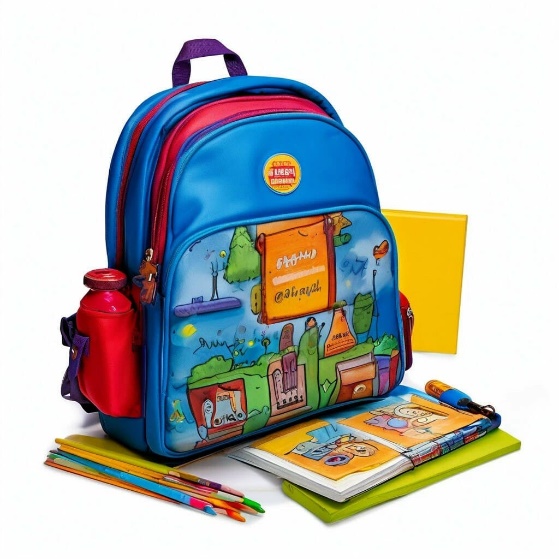 ask 1. Fill in the
blanks.
ask 1. Fill in the
blanks.
-
My name’s ___.
-
This is my __.
-
There’s a __ in my school bag.
-
There are __ in my pencil case.
-
There’s a __ too.
-
There are ___ in my bag.
-
What is there in your bag? __.
Descriptor:
A learner:
-
Reads simple sentences.
-
Understands the context of each sentence.
-
Chooses the correct words to complete the sentences.
-
Writes the correct answers in the blanks provided.
TERM 1. Unit 2: My school. Lesson 6. Describing things. Is it a …? Are they? Project
|
Learning objective |
3.3.2.1 identify some familiar words and signs on illustrations /pictures in common everyday situations 3.4.1.1 spell accurately a few high-frequency words 3.5.1.2 use the verb to be for presenting personal information and describe people and things on a limited range of familiar topics |
|
Assessment criteria |
Recognise familiar words and signs in visual contexts. Spell high-frequency words correctly. Present personal information and describe people and objects using forms of the verb "to be." |
|
Level of thinking skills |
Knowledge and comprehension, application |
Task 1. Read and circle.
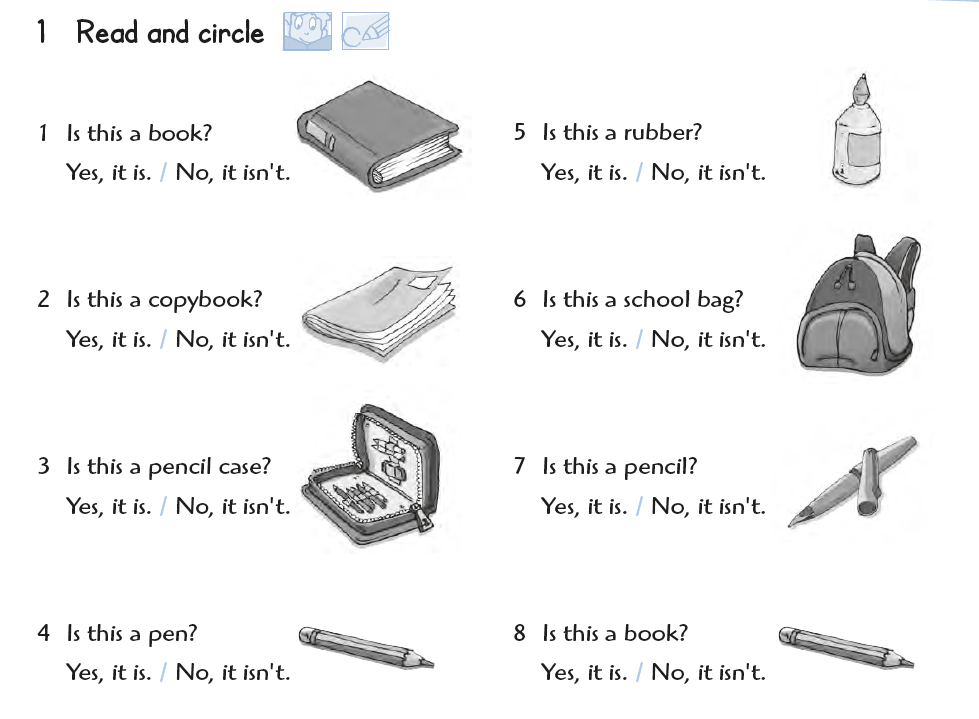
Descriptor:
A learner:
-
Reads simple questions.
-
Identifies the appropriate response.
-
Circles the correct answer.
Task 2. Look and write. Is it a … ?

Descriptor:
A learner:
-
Observes the pictures attentively.
-
Formulates a guess about the object depicted.
-
Writes a clear and concise answer in the provided space, starting with "Is it a ..."
TERM 2. Unit 3: People I love. Lesson 1: Family and friends
|
Learning objective |
3.3.2.1 identify some familiar words and signs on illustrations/pictures in common everyday situations 3.4.2.2 use words and short simple phrases to complete a written text at a sentence level |
|
Assessment criteria |
Recognise familiar words and signs in visual contexts. Complete sentences with appropriate words and phrases. |
|
Level of thinking skills |
Knowledge and comprehension, application |
Task 1. Number the picture.

Descriptor:
A learner:
-
Identifies family members in pictures.
-
Numbers them according to their relationships (e.g., sister, dad, grandma).
Task 2.

Descriptor:
A leaner:
-
Looks at the pictures carefully.
-
Identifies the family member and their possessions.
-
Writes short sentences to describe what each family member owns based on the pictures.
TERM 2. Unit 3: People I love. Lesson 2: Who’s this? has got
|
Learning objective |
3.3.2.1 identify some familiar words and signs on illustrations /pictures in common everyday situations 3.5.1.11 use has got/ have got; there is/are in a limited range of familiar topics |
|
Assessment criteria |
Recognise familiar words and signs in visual contexts. Use "has got," "have got," "there is," and "there are" correctly to describe possession and existence. |
|
Level of thinking skills |
Knowledge and comprehension, application |
Task 1. Number the pictures.

Descriptor:
A learner:
-
Looks at pictures to understand who is in each one.
-
Matches each picture with the correct label (e.g., "I'm Grandma," "I'm Mum").
-
Writes the corresponding numbers next to each picture based on the labels provided.
Task 2. Fill in the gaps in the dialogue.
Jordan: Have you … any brothers and sister, Lucy?
Lucy: No, I … . What about you?
Jordan: I’ve … a sister, but I haven’t got any brothers.
Lucy: Is your sister married?
Jordan: Yes, she is.
Lucy: … she got any children?
Jordan: No, she … . Well not yet, anyway.
Lucy: … you … a photo?
Jordan: Yes, I … . I’ve got some photos of my family in the drawer over there.
Lucy: Oh, she’s … lovely long dark hair.
Jordan: No, she hasn’t got dark hair. She’s … fair hair… . Oh, that isn’t my sister. That’s … er … Rachel, - an old girlfriend. Now why … I … that in there?
Lucy: Yes, I wonder.
Descriptor:
A learner:
-
Reads a dialogue with basic vocabulary.
-
Understands and selects appropriate words to complete gaps in the dialogue.
-
Writes the correct missing words in the blanks provided.
-
Demonstrates basic comprehension of family-related questions and responses in English.
Task 3. Answer the questions.
1. Jordan has got a sister.
Yes. No. We don't know.
2. Lucy has got a brother.
Yes. No. We don't know.
3. Jordan’s sister has got long dark hair.
Yes. No. We don't know.
4. Jordan’s sister has 2 children.
Yes. No. We don't know.
5. Lucy has got a sister and a brother.
Yes. No. We don't know.
6. Lucy has got light grey hair.
Yes. No. We don't know.
7. Rachael is Jordan’s sister.
Yes. No. We don't know.
8. Jordan has got some photos of his family upstairs.
Yes. No. We don't know.
Descriptor:
A learner:
-
Reads questions about Jordan and Lucy.
-
Chooses the correct answers (Yes, No, We don't know).
TERM 2. Unit 3: People I love. Lesson 3: People’s feelings
|
Learning objective |
3.4.1.1 spell accurately a few high-frequency words |
|
Assessment criteria |
Spell high-frequency words correctly. |
|
Level of thinking skills |
Knowledge and comprehension, application |
Task 1. Complete the puzzle.

Descriptor:
A learner:
-
Looks at each picture clue in the crossword.
-
Identifies the corresponding word represented by each picture.
-
Completes the words with the missing letters;
-
Spells words properly.
TERM 2. Unit 3: People I love. Lesson 4: Phonics
|
Learning objective |
3.3.1.1 recognise sounds and name the letters of the alphabet 3.4.1.1 spell accurately a few high-frequency words |
|
Assessment criteria |
Name letters and associate them with their sounds. Spell high-frequency words correctly. |
|
Level of thinking skills |
Knowledge and comprehension, application |
Task 1. Write.

Descriptor:
A learner:
-
Looks at the pictures.
-
Identifies objects depicted.
-
Writes down the first letter of each word associated with the pictures.
Task 2. Read and write the letters a, b, c and d.

Descriptor:
A learner:
-
Reads sentences containing missing words.
-
Identifies the appropriate words (a, b, c, d) to complete each sentence correctly.
-
Writes the chosen words in the blanks provided.
TERM 2. Unit 3: People I love. Lesson 5: My feelings
|
Learning objective |
3.3.5.1 read short, illustrated fiction and non-fiction stories written in very simple language using a dictionary |
|
Assessment criteria |
Read and understand short stories with visual support, using a dictionary to clarify unfamiliar words. |
|
Level of thinking skills |
Knowledge and comprehension, application |
T ask 1.
Read.
ask 1.
Read.
My feelings
I cry when I fall over.
I cry when I am sad.
I cry when Mum is angry,
When I do something bad.
I smile when I am happy.
I smile when I am good.
I smile when I am brave,
When I do something good.
Descriptor:
A learner:
• Reads the given sentences.
• Identifies emotions associated with different situations.
Task 2. Read again and write T (true) or F (false).
1 I cry when I am happy. F
2 I smile when I do something good.
3 I cry when I am sad.
4 I smile when Mum is angry.
5 I smile when I am brave.
6 I cry when I do something good.
Descriptor:
A learner:
-
Reads the statements related to the poem.
-
Compares each statement to the poem to determine its accuracy.
-
Writes "T" for true statements and "F" for false statements.
TERM 2. Unit 3: People I love. Lesson 6: People’s feelings
|
Learning objective |
3.5.1.2 use the verb "to be" for presenting personal information and describing people and things on a limited range of familiar topics 3.5.1.4 use common adjectives in descriptions of people and things and simple feelings with support |
|
Assessment criteria |
Present personal information and describe people and objects using forms of the verb "to be." Use adjectives accurately to describe people, objects, and feelings in sentences. |
|
Level of thinking skills |
Knowledge and comprehension, application |
1 Task 1. Complete. (‘re / aren’t)

Descriptor:
A learner:
-
Observes and analyzes the pictures provided.
-
Reads the incomplete sentences carefully.
-
Selects the appropriate words ('re' or 'aren't) to complete the sentences based on the context of the pictures.
-
Writes the correct words in the blanks to complete the sentences accurately.
Task 2. Look and write.

Descriptor:
A learner
-
Reads the given sentences.
-
Looks at the pictures to understand the context.
-
Chooses the appropriate words to complete the sentences.
-
Writes the correct answers in the blanks.
TERM 2. Unit 4: Weather. Lesson 1. The weather
|
Learning objective |
3.4.1.1 spell accurately a few high-frequency words |
|
Assessment criteria |
Spell high-frequency words correctly. |
|
Level of thinking skills |
Knowledge and comprehension, application |
Task 1. Find and circle the weather words. Then write.
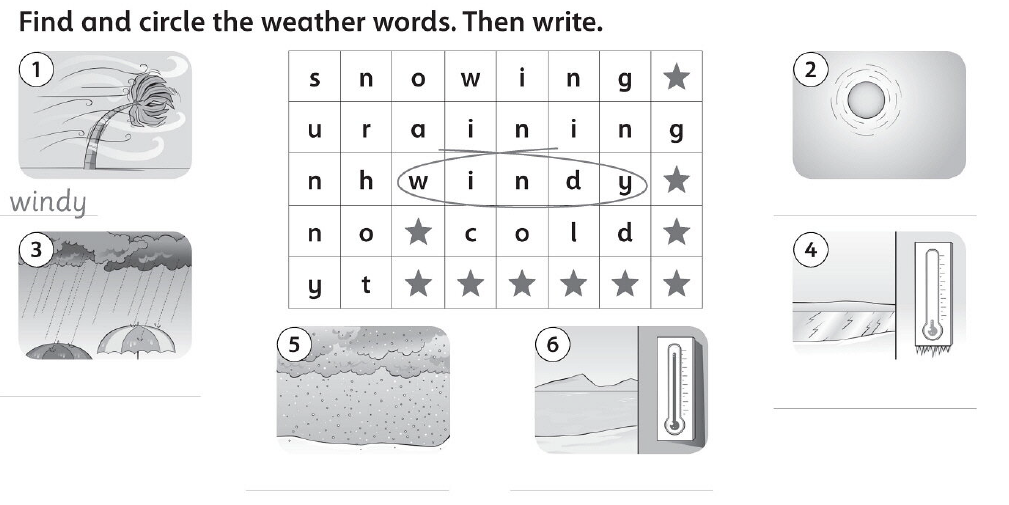
Descriptor:
A learner:
-
Identifies weather-related words hidden in a grid of letters.
-
Circles each identified word accurately.
-
Writes down the circled words in the provided space.
Task 2. Complete the puzzle.

Descriptor:
A learner:
-
Looks at each picture in the puzzle.
-
Identifies the weather-related word depicted.
-
Spells each word accurately in the crossword grid.
TERM 2. Unit 4: Weather. Lesson 2. The weather
|
Learning objective |
3.4.2.2 use words and short simple phrases to complete a written text at a sentence level |
|
Assessment criteria |
Complete sentences with appropriate words and phrases. |
|
Level of thinking skills |
Knowledge and comprehension, application |
Task 1. Write.
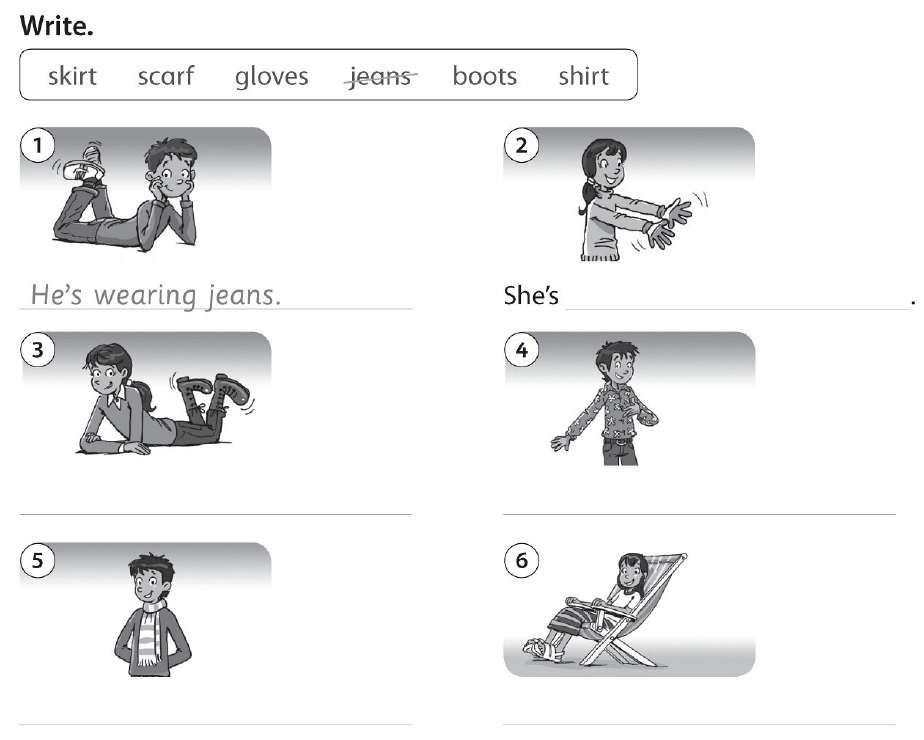
Descriptor:
A learner:
-
Looks at the pictures.
-
Matches each picture to the correct word from the list.
-
Writes down the complete sentence next to each picture.

Descriptor:
A learner:
-
Reads sentences.
-
Selects the correct words (go, open, put, don’t) to fill in the blanks.
-
Writes the chosen words in the correct places to complete the sentences.
TERM 2. Unit 4: Weather. Lesson 3. Month in a year
|
Learning objective |
3.4.1.1 spell accurately a few high-frequency words |
|
Assessment criteria |
Spell high-frequency words correctly. |
|
Level of thinking skills |
Knowledge and comprehension, application |
Task 1. Fill in the missing letters. Put the months of the year in order.
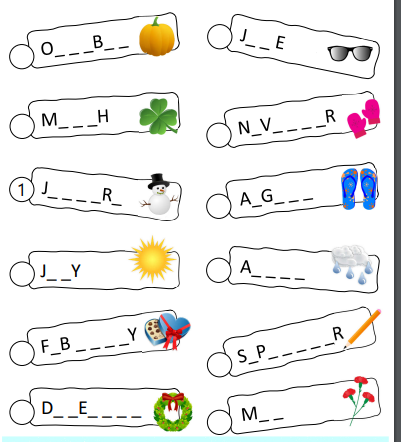
Descriptor:
A learner:
-
Observes a sequence of incomplete months.
-
Identifies the missing letters to complete each month.
-
Arranges the completed months in the correct order from January to December.
TERM 2. Unit 4: Weather. Lesson 4. Phonics
|
Learning objective |
3.3.1.1 recognise sounds and name the letters of the alphabet 3.4.1.1 spell accurately a few high-frequency words |
|
Assessment criteria |
Name letters and associate them with their sounds. Spell high-frequency words correctly. |
|
Level of thinking skills |
Knowledge and comprehension, application |
Task 1. Write.

Descriptor:
A learner:
-
Looks at the pictures.
-
Identifies objects depicted.
-
Writes down the first letter of each word associated with the pictures.
Task 2. Read and write the letters e, f, g and h.

Descriptor:
A learner:
-
Reads sentences containing missing words.
-
Identifies the appropriate words (e, f, g, h) to complete each sentence correctly.
-
Writes the chosen words in the blanks provided.
TERM 2. Unit 4: Weather. Lesson 5. Changing seasons
|
Learning objective |
3.4.1.1 spell accurately a few high-frequency words 3.3.5.1 read short, illustrated fiction and non-fiction stories written in very simple language using a dictionary |
|
Assessment criteria |
Spell high-frequency words correctly. Read and understand short stories with visual support, using a dictionary to clarify unfamiliar words. |
|
Level of thinking skills |
Knowledge and comprehension, application |
Task 1. Complete the words. Number the words to match the pictures.
 Descriptor:
Descriptor:
A learner:
-
Looks at pictures.
-
Identifies the missing letters in incomplete words.
-
Matches the completed words to corresponding numbered pictures.
Task 2. Read the story in SB. p.32 again and put the sentences in the correct order.

Descriptor:
A learner:
-
Reads the story from SB page 32.
-
Rearranges the sentences to form a coherent story.
-
Places the sentences in the correct sequential order.
TERM 2. Unit 4: Weather. Lesson 6. Changing seasons. Is it?
|
Learning objective |
3.4.2.2 use words and short simple phrases to complete a written text at a sentence level 3.3.5.1 read short, illustrated fiction and non-fiction stories written in very simple language using a dictionary |
|
Assessment criteria |
Complete sentences with appropriate words and phrases. Read and understand short stories with visual support, using a dictionary to clarify unfamiliar words. |
|
Level of thinking skills |
Knowledge and comprehension, application |
Task 1. Circle the odd one out. Write.
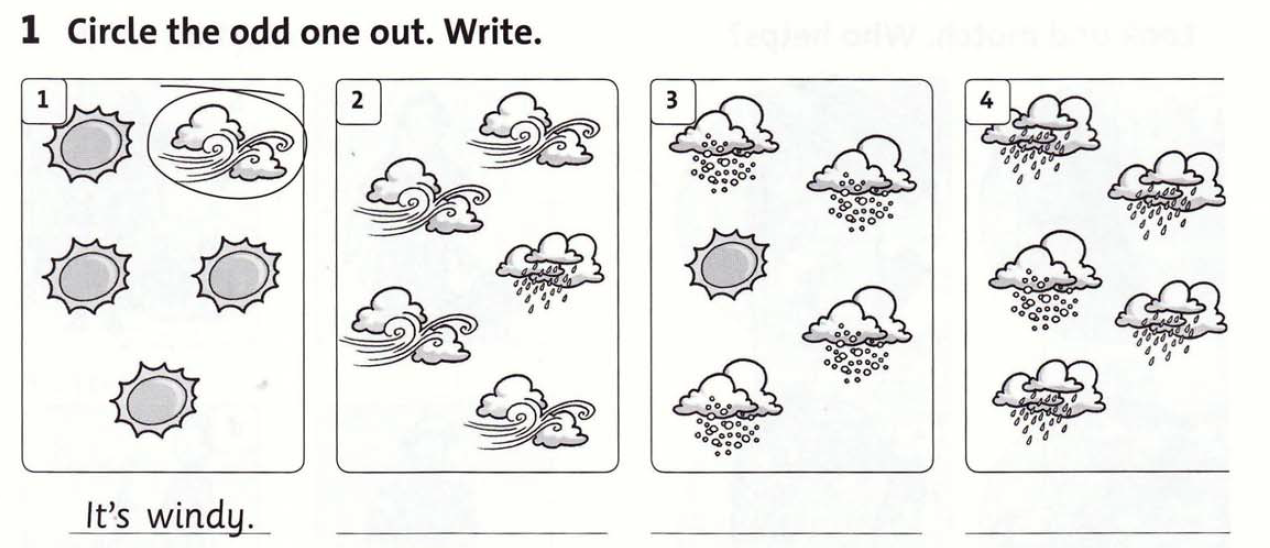
Descriptor:
A learner:
-
Looks at a set of pictures.
-
Identifies the picture that is different from the others.
-
Circles the odd one out and writes the corresponding word.
Task 2. Match the sentences with the pictures. Write a or b.
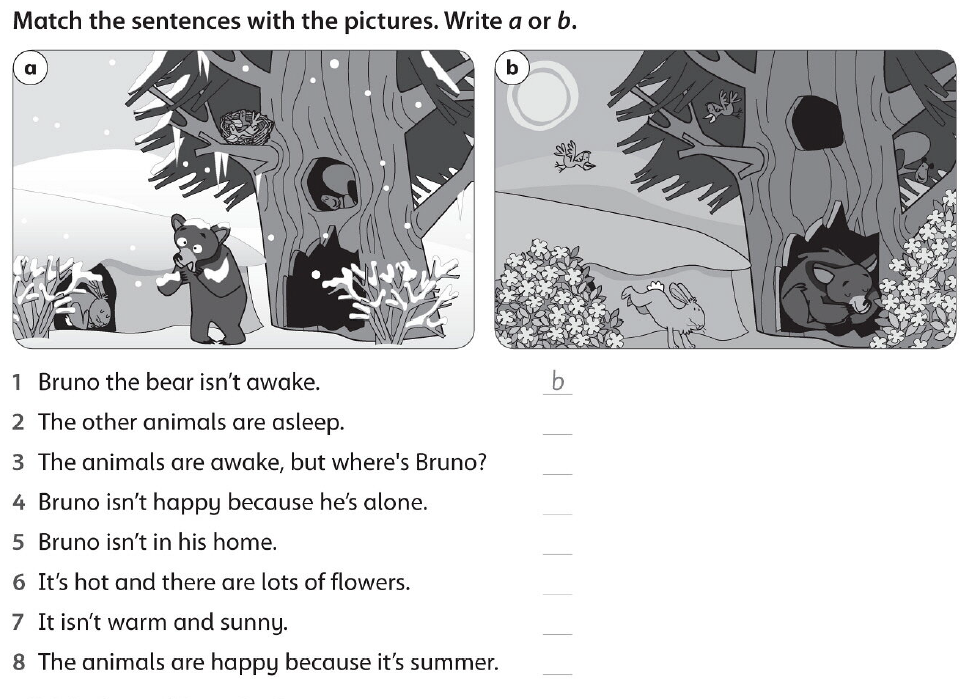
Descriptor:
A learner:
-
Reads sentences describing scenes involving animals.
-
Matches each sentence to the corresponding picture showing animals and their surroundings.
-
Writes either 'a' or 'b' to indicate the correct match for each sentence.
Task 3.

Descriptor:
A learner:
-
Understands words for seasons.
-
Chooses the right word for each sentence.
-
Fills in the blanks with correct answers.















